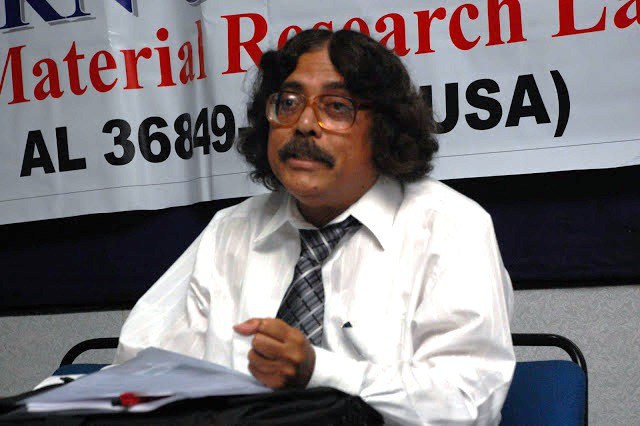Unresolved Critical Issues On Nobel Prize; “Thakur’s Equation”

New Delhi, January 26, 2020: It now stands established that the central equation of the 2014 Nobel document is from earlier works on nonlinear optics by the NRI scientist Professor Mrinal Thakur.
The Judge of an US court has referred to this equation (equation 3 of the Nobel document of 2014) as “Thakur’s Equation” which is Δ = λ/(2nsinα(1 + I/Is)1/2), where Δ stands for resolution and I stands for laser light intensity.
Earlier nominated for the Nobel Prize in Chemistry for 18 times, Professor Thakur currently is working as Director of Photonic Materials Research Laboratory of Auburn University in USA.

However, what violates the academic norms is the fact that in the Nobel document of 2014, no credit was given to Professor Thakur for this equation and the underlying experimental and theoretical works in nonlinear optics that he performed.
The US court’s mention of the “Thakur’s Equation” came in response to a case of plagiarism filed by the NRI scientist against the 2014 Nobel Laureates in Chemistry.
The Judge ruled there is no law against plagiarism (despite the consequences) in California, USA.However, in recent official communications, Stanford and UC Berkeley(where Moerner and Betzig work) have passed the blame of plagiarism to The Max Planck Institute in Germany (where Hell is employed).
Academic Norms Violated in The 2000 Chemistry Nobel Prize
The 2000 Chemistry Nobel Prize was awarded for the discovery of Conductive Polymers. The Royal Swedish Academy of Sciences gave the award only to those who discovered “Conjugated” conductive polymers and excluded Professor Thakur for his discovery of “Nonconjugated” conductive polymers.
The document preserved at the Nobel Foundation website for the 2000 Nobel Prize in chemistry is fundamentally incorrect.
Alan Heeger, A.G. MacDiarmid and H. Shirakawa, recipients of the Nobel Prize for chemistry in 2000, made fundamentally incorrect (nonfactual) statements in their Nobel document that only conjugated polymers can be electrically conductive.
Legal communications involving US attorneys have recently established that these Nobel recipients have agreed at the legal-level that Professor Thakur’s experimental works and theory are fundamentally correct while theirs are fundamentally incorrect!
Overall, the following four critical issues have remained unresolved:
- No credit was given to Professor Thakur in 2000 Nobel Prize and afterwards for his discovery of “Nonconjugated Conductive Polymers.”
- The Royal Swedish Academy is yet to correct the document preserved at the Nobel Foundation website despite repeated requests. The document states a polymer must be conjugated to be electrically conductive – which is nonfactual and the corresponding theory as given is incorrect.
- Professor Thakur’s research funding was abruptly stopped in 2003 as he brought up the incorrectness and inequity regarding the 2000 Nobel Prize in Chemistry.
- Professor Thakur stakes claim to the 2014 Nobel Prize in Chemistry as well since “Super-resolved Fluorescence Microscopy” (2014 Nobel in Chemistry)is primarily based on earlier nonlinear optical experimental and theoretical studies performed by Professor Thakur and colleagues on organic materials.
Professor Thakur sought intervention of Prime Minister Modi of India, Prime Minister Lofven of Sweden, and President Trump of USA to help resolve these critical issues but so far they have taken no positive action on this matter.
Scientific Explanation of Thakur’s Equation
The 2014 Nobel Prize in Chemistry was awarded to Betzig, Hell and Moerner for their works on “Super-Resolved Fluorescence Microscopy.”
The nonlinear optical coefficients as a function of wavelength, excited-state lifetimes, two-photon absorption and the detailed saturation dynamics have all been measured using femtosecond-duration pulses and their theoretical interpretations have been established.
The excited state lifetime as measured is about 1.8 ps. In the off-resonant domain the response is instantaneous.
As discussed in such reports, (phase-space filling model applied to PTS-polydiacetylene crystal), the fractional change in oscillator strength, δf/f is related to the number fraction of electrons (excitons) involved in the transitions as given in the following:δf/f = – N/Nswhere Ns is the saturation density.
For organic materials, energy levels remain essentially unchanged when light is incident on it. Using the phase-space filling model as above verified by detailed experimental measurements (Thakur et al. 1985-88), the equation relating the resolution and laser light intensity (Thakur’s Equation) that one arrives at isΔ = λ/(2nsinα(1 + I/Is)1/2). HereΔ stands for resolution, I stands for laser light intensity, λ is wavelength, n is refractive index,α is semi-aperture angle and Isis saturation intensity. More details of the equation have recently appeared (Thakur, J. Macromol. Sci., PAC 2016 and references therein).
This is the central equation, Equation 3 given in page 5 of the 2014 Nobel document preserved at the Nobel Foundation website and is derived based on phase-space filling model and the statistics involved in the emission process. No reference for this equation was provided in that document.
In conclusion, super-resolved fluorescence microcopy, in particular stimulated emission depletion microscope is essentially based on femtosecond pump-probe measurement in third order optics of organic materials.The mechanisms are adopted from earlier experimental and theoretical studies in third order optics involving well-defined materials such as polydiacetylene single-crystal films. The correlation between the line-width (resolution) and optical intensity is developed using phase-space-filling model used in the case of PTS-polydiacetylene film.
Protection against Nuclear Radiation, Thyroid Cancer
Professor Thakur discussed a wide range of applications of nonconjugated conductive polymers he invented, for protection against nuclear radiation including radioactive iodine.
These polymers efficiently absorb iodine when iodine atoms come in contact with them rendering the iodine atoms immobile. These protective plastics should be installed as a layer/sheet all around any nuclear reactor or nuclear waste storage facility so that any emitted radioactive iodine is absorbed within the plastic and can not leak out to the environment.
Among radioactive species emitted by nuclear reactors, radioactive iodine is particularly dangerous since it remains as a vapor at ordinary temperature and can travel long distances by air-currents.
Radioactive iodine emitted from Fukushima plants, Japan, crossed the Pacific Ocean to arrive at California, USA and has been reported to have caused health hazards! Radioactive iodine is readily absorbed by human body and causes thyroid cancer and other serious ailments.
In hospitals and clinics, the doctors, nurses and attendees are often worried of being exposed to radioactive iodine during and after radio-iodine therapy of patients having thyroid cancer and hyperthyroidism.
Patients emit radiation for a number of days after taking a capsule containing radioiodine. Use of apparels made of the nonconjugated conductive polymers reduces the potential exposure to radioiodine and lessens the anxiety. Thyroid cancer cases in USA have tripled in the last three decades (NBC news, August 2016) probably because of the large number of nuclear reactors (about 100 of those) in USA.
Professor Thakur’s scientific works have been accepted by the entire gamut of polymer scientists and his discoveries have appeared in many major scientific journals in USA and outside. He has hundreds of research publications. His research has made wide impact in polymer science as well as in the branches of nonlinear optics and nanoparticles.
His discovery on protective shields is expected to make profound impact by making the planet/ mother earth safer as its applications can safeguard the living beings/environment against radioiodine emission caused by nuclear power plants, nuclear spent-fuel-rods, rocket/space satellite launching stations, other nuclear reactors as in nuclear-powered ships/submarines, nuclear fallouts, as well as in administering nuclear medicine.
Professor Thakur is hopeful that this press conference will help gaining academic and world-attention to this important matter.






More and more people are interested in the discoveries and developments of the 20th century, the Nobel Prize is truly a symbol of the greatest successes of the century, whether it be science, economics or peace.